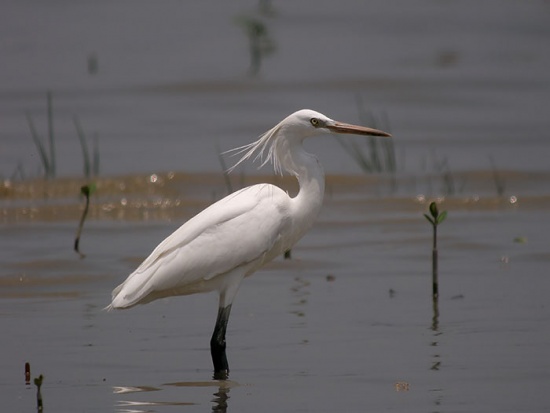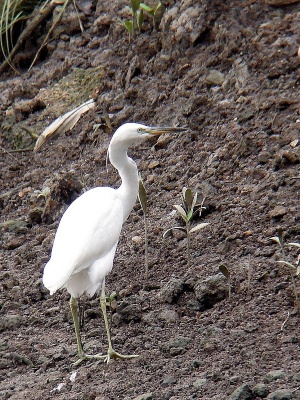- Egretta eulophotes
Identification
65–68 cm (25½-26¾ in)
White, full crest, yellow bill
Breeding adult
- Blue facial skin
- Short nape plumes
- Long back and breast plumes
- Long black legs
- Greenish-yellow feet
Non-breeding adult shows largely orange-yellowish base to two-thirds of lower mandible and yellow along cutting edge of upper mandible.
Similar species
On Little Egret, upper edge of the bare facial skin is straight from eye to bill, in Chinese Egret that line goes down before going back up[4].
To distinguish non-breeding Chinese and Little Egret, look at the lower mandible. The lower mandible of non-breeding Chinese Egret is more orange-yellow while that of non-breeding Little Egret is dull yellow and indistinct. Legs of the Chinese Egret is greenish-yellow while that of the Little Egret is black (but Little Egret could also display greenish legs - refer to image at http://www.flickr.com/photos/avianphotography/8124305594/in/photostream/).
Distribution
Very rare and little-known.
Breeding range is unclear: colonies in southern China, possibly elsewhere in China, in North Korea around Taegam Island and perhaps on the coast of the Russian Far East.
Migratory but extent of movements little-known. Recorded in South Korea, southern Japan and the Ryukyu Islands, Hong Kong, Thailand, Malaya, Singapore, Borneo and Philippines.
Vagrant recorded on Christmas Island. Also accidental vagrant to Agattu Island, Alaska.
Taxonomy
This is a monotypic species[1].
Habitat
Tidal estuaries and mudflats, occasional in other coastal wetland habitats such as rice fields.
Behaviour
Breeding
They breed in colonies on offshore islands on cliffs, in trees and low bushes and fly to mainland mudflats to feed. They build a disc shaped nest from straw and plants. The clutch of 3-5 eggs is incubated by the female for 24-30 days. The female cares for the young.
Diet
They primarily eat small fish, shrimps and crabs, with the addition of some frogs and grasshoppers. Seems to have a characteristic hunched stature before they dart forward to try to catch a prey.
References
- Clements, J. F., T. S. Schulenberg, M. J. Iliff, D. Roberson, T. A. Fredericks, B. L. Sullivan, and C. L. Wood. 2017. The eBird/Clements checklist of birds of the world: v2017, with updates to August 2017. Downloaded from http://www.birds.cornell.edu/clementschecklist/download/
- BirdLife International
- ARKive
- Birdforum thread discussing id of Little vs Chinese Egret
- Handbook of the Birds of the World Alive (retrieved July 2018)
Recommended Citation
- BirdForum Opus contributors. (2024) Chinese Egret. In: BirdForum, the forum for wild birds and birding. Retrieved 26 April 2024 from https://www.birdforum.net/opus/Chinese_Egret
External Links
GSearch checked for 2020 platform.1






